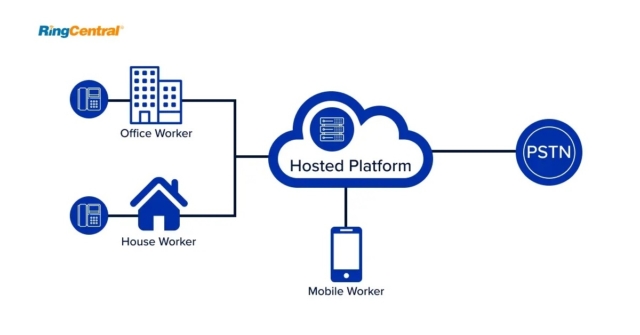AI is changing the game for business communication. Traditional phone systems are evolving into intelligent platforms powered by AI, offering more than just smarter calls. It’s about automation, personalisation, and valuable insights. Businesses can automate tasks, gain actionable data, and deliver tailored experiences like intelligent call routing and sentiment analysis. Imagine a world where customers reach the right agent immediately, and employees are empowered to focus on complex issues. This is the future powered by AI.
As a leading provider of cloud-based business communications, RingCentral is at the forefront of this evolution. Through its AI-Powered Telephone System, RingCentral exemplifies how AI can enhance communication efficiency. This system, alongside other AI-powered platforms, empowers employees, streamlines workflows, and fosters deeper connections with customers by offering features like intelligent call routing and personalised interactions.
In this article, we’ll delve deeper into the integration of AI in telephony, using RingCentral as a prime example. We’ll explore the benefits, challenges, and implications of AI-driven Communication Solutions in today’s dynamic business landscape. By embracing AI-powered communication solutions, businesses can unlock a new era of efficiency, customer satisfaction, and employee empowerment.
Key Takeaways
- AI automates tasks, personalised interactions, and analyses communication data to generate valuable insights. (Exemplified by platforms like RingCentral’s cloud communications platform with AI functionalities)
- Benefits include enhanced efficiency, improved customer experience, cost savings, and data-driven decision-making.
- Integration challenges include technical considerations, data privacy concerns, and employee training needs.
What is a telephony?
Telephony refers to the technology that enables voice communication over networks. It encompasses traditional landline phone systems but has evolved to include newer technologies like Voice over Internet Protocol (VoIP). VoIP transmits voice calls digitally over a broadband internet connection, offering features such as video conferencing and instant messaging alongside traditional voice calls. Telephony is the foundation for phone calls, allowing us to connect and collaborate across distances.

____
What is artificial intelligence (AI)?
On the other hand, AI (Artificial Intelligence) is a branch of computer science concerned with creating intelligent machines that can mimic human cognitive functions. AI can analyse vast data, identify patterns, and learn and adapt over time.
When these two forces converge, AI can analyse vast swathes of telephony data, including data from VoIP calls, to identify call patterns, predict trends and automate routine tasks. This powerful synergy unlocks a multitude of benefits for businesses, including:
- Enhanced Communication Efficiency: AI automates tedious tasks like call routing and screening, freeing employees to focus on higher-value activities. Imagine agents no longer wasting time transferring calls; instead, AI efficiently directs them to the most qualified representative for faster resolution.
- Improved Customer Experience: AI personalises interactions by analysing customer data and tailoring responses. For example, AI-powered virtual assistants can answer simple questions, schedule appointments, and even offer product recommendations while maintaining a friendly and helpful tone. This translates to shorter wait times, a more streamlined experience, and ultimately, happier customers.
- Data-driven decision-making: AI analyses call recordings and interactions to extract valuable insights. This data can be used to identify trends, optimise call centre operations, and even improve product development. Sentiment analysis, a subfield of AI, can gauge customer satisfaction from call conversations, allowing businesses to proactively address potential issues and refine their customer service strategies.
____
RingCentral: A Case Study in AI-Powered Telephony

RingCentral, a leading provider of cloud-based business communication solutions, offers a comprehensive platform that surpasses traditional phone systems by integrating cutting-edge AI functionalities. Here’s a closer look at some key features:
-
Intelligent Call Routing and Management
Gone are the days of navigating complex phone menus. AI analyses factors like caller history, agent skills, and real-time availability to route calls to the most suitable agent, ensuring faster resolution times and a more positive customer experience.
-
Natural Language Processing (NLP) for Automated Interactions
AI-powered chatbots and virtual assistants can handle basic inquiries, troubleshoot common issues, and even schedule appointments. This frees up human agents for more complex tasks requiring empathy and critical thinking.
-
Voice Recognition and Authentication
Security and convenience are paramount with AI. Voice recognition allows for secure caller identification and streamlines processes by enabling control through voice commands. Imagine streamlining tasks like logging into accounts or accessing information simply by using your voice.
-
Predictive Analytics for Call Volume Management
AI analyses historical call data to predict future call volume patterns. Businesses can utilise this information to optimise staffing levels and resource allocation. This proactive approach ensures adequate personnel are available to handle peak call periods, minimising wait times and maximising customer satisfaction.
____
Benefits of AI-Powered Telephone Systems
The advantages of AI-powered telephony systems extend far beyond simply streamlining operations. They offer a holistic range of benefits that impact not just efficiency, but also customer experience, employee satisfaction, and ultimately, the bottom line. Here’s a deeper dive into the tangible benefits businesses can expect:
-
Enhanced Communication Efficiency and Productivity
As mentioned earlier, AI automates tasks and optimises call routing, freeing up employees to focus on more strategic work. This translates not only to increased productivity but also to improved employee morale. Imagine agents no longer bogged down by repetitive tasks; instead, they’re empowered to leverage their skills and engage in more meaningful interactions with customers.
-
Improved Customer Experience and Satisfaction
Faster resolution times, personalised interactions, and readily available support contribute significantly to enhanced customer satisfaction. Happy customers are not only more likely to return, but they’re also more likely to become loyal brand advocates, spreading positive word-of-mouth recommendations. In today’s competitive business landscape, fostering positive customer experiences is crucial for retention and growth.
-
Cost Savings and Operational Efficiencies
AI reduces manual workloads, lowers infrastructure costs associated with traditional phone systems and optimises resource allocation. This translates to significant cost savings across various departments. Freed-up resources can then be reinvested in other areas of the business, such as marketing campaigns or product development.
-
Improved Sales and Lead Generation
AI-powered features like call analytics can identify patterns in customer inquiries and buying behaviour. Businesses can leverage this data to refine their sales strategies, target potential customers more effectively, and convert leads into paying customers.
-
Data-Driven Decision Making
AI analyses call recordings and interactions to extract valuable insights. Sentiment analysis, for example, can gauge customer satisfaction from call conversations. This data empowers businesses to identify trends, optimise call centre operations, and even improve product development. By making data-driven decisions, businesses can ensure they’re meeting customer needs and staying ahead of the curve in a constantly evolving market.
By embracing AI-powered telephony systems, businesses can unlock a multitude of benefits that contribute to a more efficient, customer-centric, and ultimately, successful operation.
____
AI Integration Challenges in Telephony
While AI-powered telephony systems offer a wealth of benefits, seamlessly integrating them requires careful planning and consideration. Here are some key challenges and considerations to keep in mind:
- Technical Challenges: Integrating AI with existing phone systems and infrastructure can be complex. Businesses may need to invest in upgrades or adopt new technologies to ensure compatibility. Additionally, ongoing maintenance is crucial to ensure smooth operation and maximise the potential of the AI features.
- Data Privacy and Security Considerations: Data security is paramount in today’s digital landscape. Businesses need to ensure the chosen AI-powered telephony system prioritises data security. Look for providers with robust security measures in place, such as encryption and access controls. Additionally, compliance with relevant data privacy regulations is essential. Companies like RingCentral prioritise data security with robust security measures and adhere to industry compliance standards to safeguard user privacy.
- Training and Adoption Strategies: A successful AI implementation requires a well-defined training programme for employees. Employees need to understand the new functionalities and how to leverage them effectively. Training should cover not only the technical aspects but also the potential impact of AI on workflows and customer interactions. Developing a change management strategy can also be beneficial to ensure employee buy-in and smooth adoption of the new system.
____
The Future of AI-powered Telephony Systems
The future of AI-powered telephony systems is brimming with exciting possibilities:
-
Potential Advancements in AI Technology
As AI technology continues to evolve, we can expect even more sophisticated features and capabilities. Imagine AI-powered systems that can analyse customer sentiment in real-time, personalise communication-based on individual needs, and even offer real-time coaching to agents during calls.
-
Opportunities for Innovation and Growth
AI opens doors for innovation in areas beyond just call routing and automation. Imagine AI-powered systems that conduct sentiment analysis to gauge customer satisfaction, identify potential churn risks, and proactively address customer concerns. Additionally, AI can be used to personalise communication strategies, tailor marketing campaigns, and ultimately, foster deeper customer relationships.
-
Predictions for the Future of AI-Powered Telephone Systems
AI-powered telephony systems are poised to become the standard, transforming how businesses communicate with customers and employees. These intelligent systems will streamline operations, empower employees, personalise customer experiences, and unlock valuable data insights for strategic decision-making.
____
Conclusion
- Assess specific communication needs to ensure the chosen AI-powered telephony solution solves critical challenges.
- Invest in employee training to maximise system use and ensure a smooth transition to new functionalities.
- Prioritise data security by selecting providers with robust encryption and compliance with privacy regulations.
- By taking these steps, businesses can leverage AI-powered telephony to gain a competitive advantage in the evolving communication landscape.
Updated Sep 12, 2024



